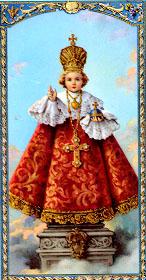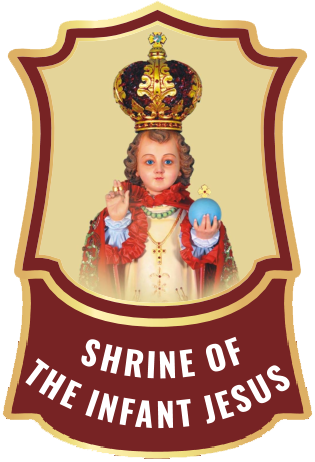DEVOTION OF THE INFANT JESUS

In the year 1620, November 8, Ferdinand II, Emperor of Austria, gained a signal victory over the united Protestant armies in a battle fought at White Mountain near the city of Prague.
He ascribed the victory to the special intervention of the Infant Jesus. Before the signal was given to attack, the Catholic leaders were in consultation. In their midst was the saintly and learned Carmelite priest. Father Dominic of Jesu-Maria. Holding aloft a picture of our Lord’s Nativity, the holy priest exhorted them to go forth to battle with unwavering confidence in the all-powerful help of the Infant Jesus. They did so. Their trust in the Christ-Child was richly rewarded. The enemy was defeated.

The Church in Prague

Altar of the Infant Jesus
In gratitude for the favour and in recognition of the valuable services rendered by the Carmelite priest, the Emperor founded a Carmelite monastery at Prague, Bohemia, in the year 1624.
Little did anyone dream at that time that God had chosen this new foundation as the central point from which devotion to the Infant Jesus would radiate to all parts of the world.
Prague was to become another Bethlehem. The cradle was ready. The Occupant was to arrive later. After the religious community was organized by the Carmelite Father, no particular attention was directed to the Christ-Child. Then, from the distant country of Spain came a noble lady to Bohemia to visit her daughter, the princess Polixena of Lobkowitz. To her was presented the gift of a highly treasured family heirloom – a wooden statue (covered with wax) of rare Spanish artistic beauty, about 19 inches high, representing the Infant Jesus, clothed realistically in a little dress over which, from the shoulders, hung a royal mantle, the right hand raised in benediction, the left hand sustaining the Globe of the World as a Sign of Kingly Sovereignty, the countenance beaming with grace, majesty and clemency.
The original statue of the Child Jesus of Prague has been preserved for centuries in the former Carmelite parish church of St. Mary of Victory in the city of Prague.
In the year 1623, Prince Lobkowitz died. Thereupon, Polixena, the pious Princess, resolved to dedicate the remainder of her life to Christian works of charity. The Carmelite religious were among her favourite beneficiaries. On one occasion, when the monks were in the throes of destitution, she felt inspired to entrust. “Take this image” she said, “as long as you venerate it, you shall not want”. I GIVE YOU WHAT I PRIZE MOST HIGHLY IN THE WORLD: HONOUR AND RESPECT THE CHILD JESUS AND YOU SHALL NEVER BE IN WANT’’. Prophetic words – that were to find fulfillment in a striking degree for the monks of Prague and for millions of the faithful in subsequent years! Gradually, it became clear that the unusual statue was an instrument in the hands of God to dispense unusual blessings. The religious became aware that whenever they were fervent in venerating the Image they were the objects of extraordinary spiritual and temporal favours. When they became remiss in offering special honour to the Infant Jesus, the community was reduced to dire financial straits and experienced special monastic disturbances.
Then, in 1631, the remarkable statue seemed doomed to destruction and oblivion. The Swedish Protestant army again invaded Prague Churches. Monasteries were pillaged, sacred images were destroyed. The Carmelite monastery was plundered, the religious were ejected and the precious statue was seized by unholy hands and cast upon a heap of rubbish. There it remained for seven years, both hands broken off in the fall.
Peace had been restored. The monks had once more taken possession of their property, but had willed its restoration. To the community came Father Cyrilus who, as a novice in the community of Prague, had cultivated as extraordinary devotion to the Infant Saviour. This saintly priest firmly believed that the statue still existed. He searched for it everywhere and finally discovered the mutilated image in a heap of refuse. Tenderly, he replaced it in the Oratory. As he knelt before it, absorbed in his favoured devotion, he distinctly heard these words: “Have pity on Me and I will have pity on you. Give me my hands and I will give you peace”.
Those words were a command. He sought to fulfill it. To his relief, a sick patient gave him a generous donation to defray the expenses required for the repair of the statue. The prior decided that since the aims were fully adequate an entirely new statue should be purchased. It was brought and placed in the oratory, contrary to the express instructions of the mysterious voice. Scarcely had it been installed when it was struck by a falling candle-stick and broken to pieces. This mishap and the ensuing illness of the Prior, obliging him to resign his office, were regarded as a sign of the Infant’s displeasure at the indifference shown to the original image.
The succeeding Prior, receiving another donation for the purpose, had the statue repaired. It soon became manifest how acceptable this action was to the Divine Infant. The Prior lay critically ill, victim of a citywide pestilence. He vowed that if restored to health, he would offer holy Mass for 9 successive days before the Image. The favour was granted and his pledge fulfilled. He assigned a place of special honour to the Statue and henceforth became an ardent apostle in promoting veneration of the miraculous Infant. Not long after, the monastery again experienced one of its periodic trials of destitution. In his distress, the Prior ordered all the members of the community to take part in special prayers for relief. On the third day, an unexpected gift of aims was given them.
The time had come when the wonder working Statue merited a more wide-spread veneration through the Prior. Therefore, he had it removed to the Church adjoining the Monastery, so that the people likewise could benefit by this miraculous Infant. Devout groups of the Laity in ever growing numbers gathered about it. Extraordinary and miraculous favours were multiplied. Generous Donors came forward and soon the Statue was enshrined within a magnificent gold-plated tabernacle, in a new Chapel richly ornamental in red and white marble, all of which to this day is greatly admired for its exquisite beauty.
Soon the fame of the Miraculous Statue and its wonder-working properties spread from Prague, through Bohemia, to all parts of Europe and across the seas to America, Africa, India and China. By the year 1655, the marvelous cures and conversions and other temporal and spiritual favours had become so numerous and renowned that the Apostolic See solemnly crowned the image, thereby officially recognizing that in the designs of God it is a special object of miraculous power. Replicas of the original Statue were made in countless thousands throughout the word. Today, it is familiar to every Catholic and inspires all to venerate the Holy Image and to entertain an ardent love and devotion to the Christ-Child.
DEVOTION to the Infant of Prague is devotion to the Child Jesus, it is veneration of the Son of God, who in the form of an Infant, chose a stable for a birth place, a manger for a cradle, and shepherds for worshippers. Our Saviour grants special graces to all who’s venerate His sacred infancy.
So many graces have been received by those who’s invoke the Divine Child before the original Statue that it has been called” The Miraculous Infant Jesus of Prague”. We read the following in an old book printed in Kempt; “All who approach the miraculous Statue and pray there with confidence” receive assistance in danger, consolation in sorrows, aid in poverty, comforts in anxiety, light in spiritual darkness, streams of grace in dryness of soul, health in sickness and hope in despair”.
“No colic is so painful, no fever so violent, no malady so dangerous no peril so great, no tumor so malignant , no insanity so raving, no complaint so irritating, no assault of Satan so furious, no pestilence so infectious no swelling so serious, as not to be dispelled or cured by this blessed Child. The Holy Infant puts an end to enmities, frees prisoners, saves those who are condemned to death, brings obstinate sinners to repentance and blesses childless parents with offspring. In short, He has become all the all”.
In thanksgiving for the numerous graces and cures received, the miraculous statue may be applied also to the images of the “Little King” which are venerated everywhere, in churches and chapels, home and schools, monasteries and convents the world over. From small beginnings, this devotion has grown to great proportions; so that it is almost as universal as the Church itself. The Divine child attracts an even-increasing number of clients, who appeal to Him in every need.
In 1642, a noble lady had an elegant chapel built for the Divine Infant. This chapel was dedicated on the feast of the Holy Name of Jesus in 1644 and Holy Mass was then celebrated in it for the first time. The feast of the Holy Name of Jesus thus became the principal feast of the Miraculous Infant of Prague.
Such, Dear Reader, is a brief description of the origin and history of the Miraculous Statue and the devotion that sprang from it. May you too be inspired to love the infant Jesus. May you too experience his sweet presence and his all powerful assistance in time of sorrow, trial, temptation and all the vicissitudes of life, where you are in particular need, when all other sources of help seem to have failed, go to child Jesus and pour out the troubles of your heart to him. As he welcomed and consoled his closest friends. Mary, Joseph, the Good shepherds, on the first Christmas night, and the wise men of the East, so will he welcome and console you and bestow special graces and blessings upon you. This devotion attaches to itself a most sure pledge of eternal salvation. He came to us Child-like in sprit.
Did he not say: “Unless you become like little children, you shall not enter into the kingdom of heaven ? “
In the Providence of God, the miraculous infant Jesus of Prague was used to encourage people to venerate the Sacred Infancy of Jesus, it is most pleasing to Jesus that we remember His infinite love in appearing among us in the form of a Child to save our souls and to win our love and confidence.
